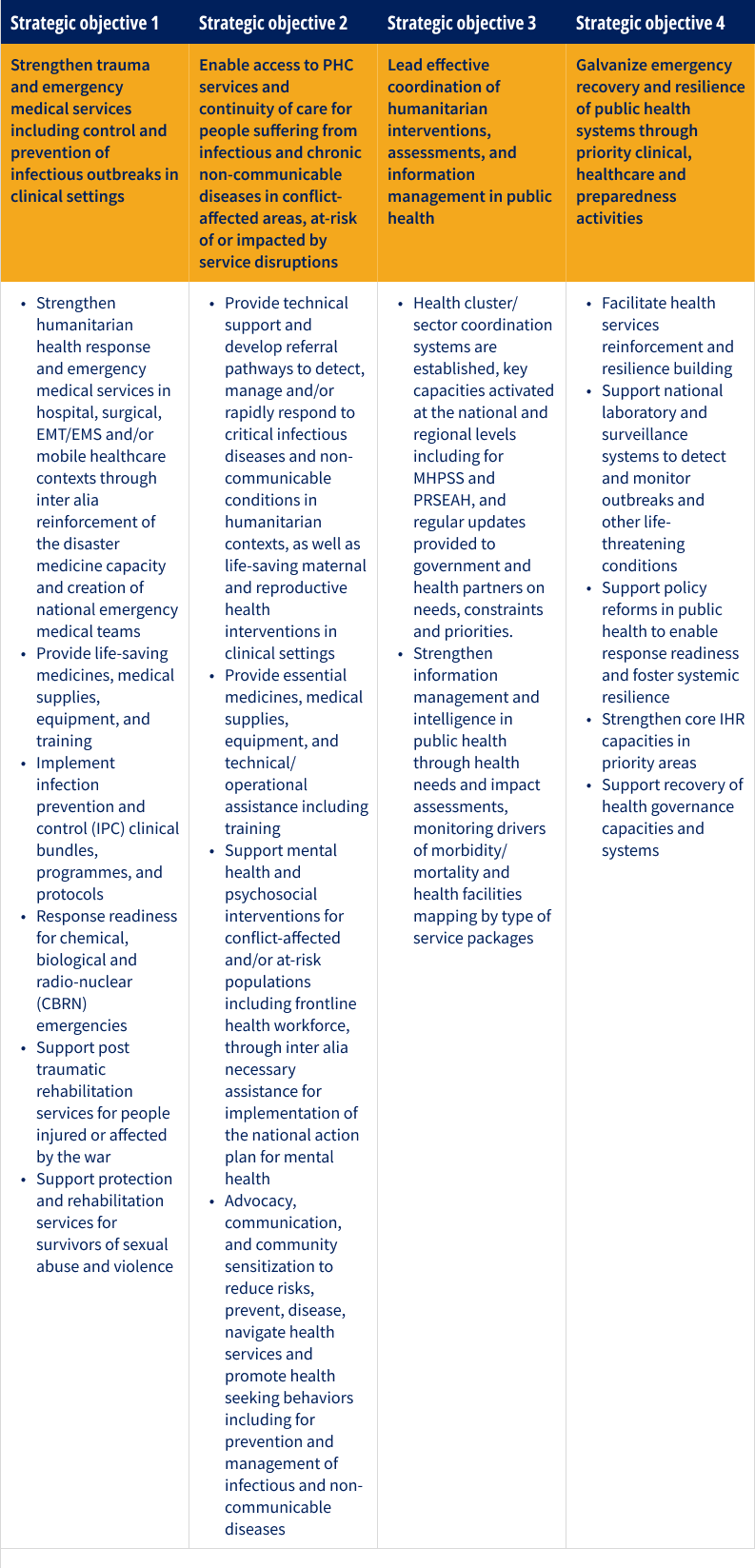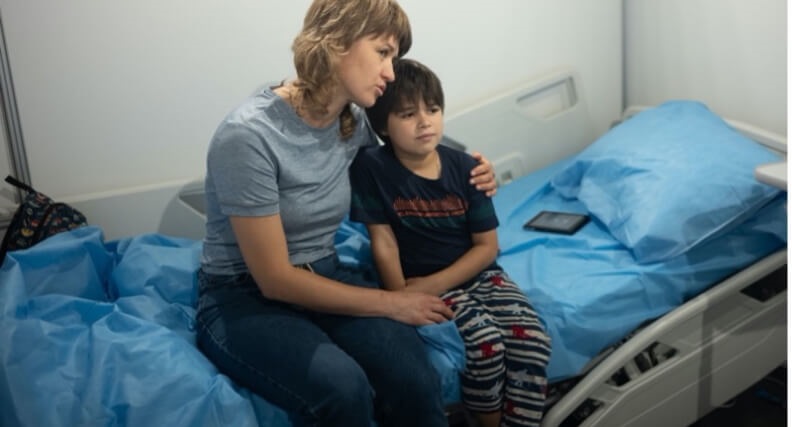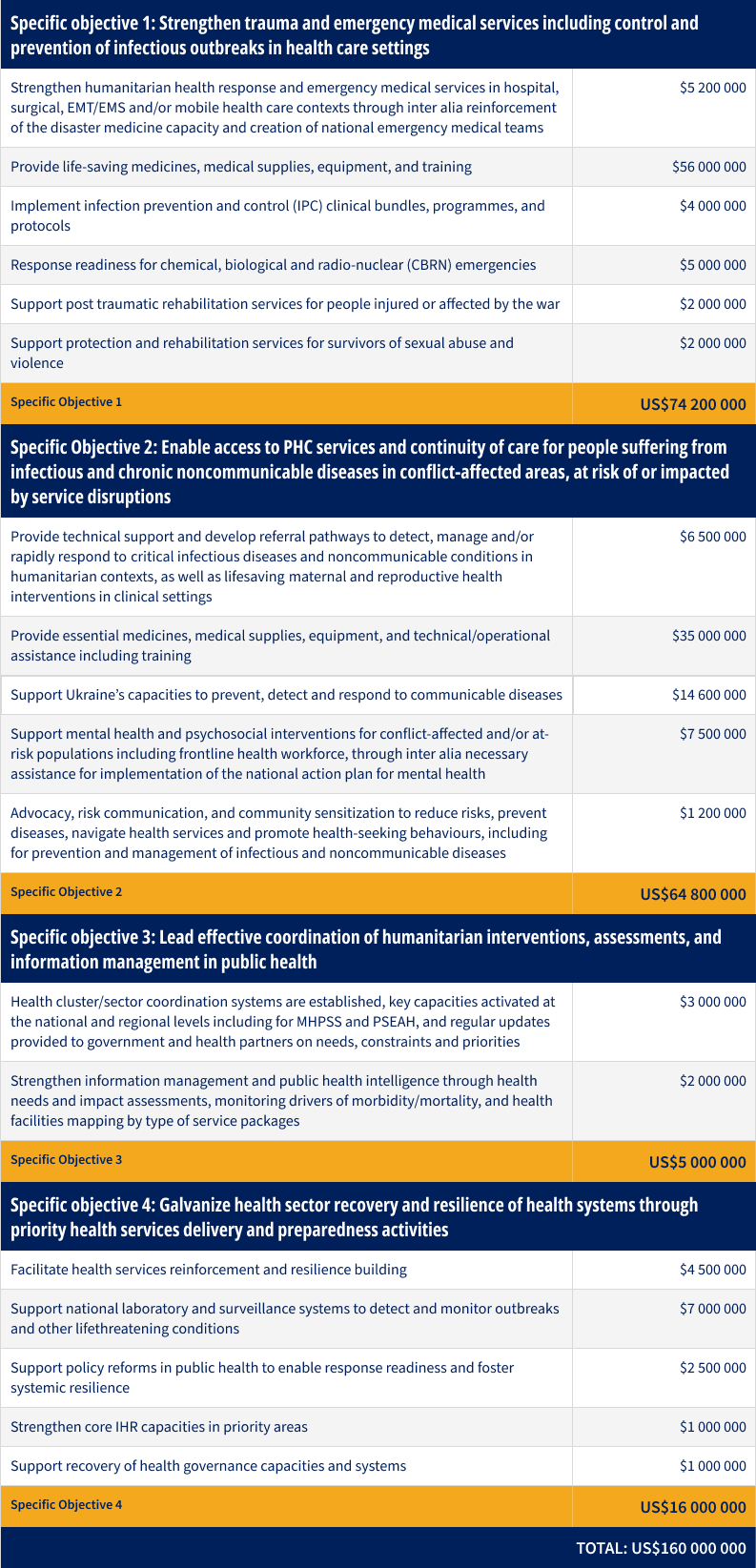
Ukraine and refugee-receiving and hosting countries
Ukraine, Grade 3 Emergency
Ukraine
- People affected by the war in Ukraine: 17.6 million
- People targeted for health assistance: 11.4 million
- Financial requirements for Ukraine and Refugee receiving and hosting countries (US$): 240 million
Context
Since the start of the crisis in Ukraine, over 14.5 million refugees have crossed the borders to other countries, with over 7.9 million still residing in refugee-hosting countries (UNHCR January 2023). Within Ukraine, around 6.24 million people are still internally displaced (OCHA updated Sept 2022). There have been approximately 17 994 civilian casualties, with 11 075 injuries and 6 919 deaths recorded by the Office of the United Nations High Commissioner for Human Rights (OHCHR) as of January 2023.
The crisis remains acute, warranting continued response from the humanitarian community within Ukraine as well as regionally and globally. From October 2022, critical civil infrastructure was increasingly targeted, including electricity and water in several major cities such as Kyiv, Lviv and Dnipro, reducing access to health care and requiring enhanced emergency medical support. This is in addition to the continued lack of access in areas under the temporary military control by the Russian Federation and the areas of Donetska and Luhanska oblasts not under the control/beyond the control of the Government of Ukraine since 2014.. Access is further disrupted due to the continuing attacks on health care. As of January 2023, WHO has verified a total of 745 attacks on health care, resulting in 131 injuries and 101 deaths.
From early September 2022, territory has been retaken in Kharkivska, Donetska and Khersonska Oblasts. According to the Ministry of Health, health care facilities in areas that have been retaken have suffered significant damage, with some completely destroyed, smaller health facilities heavily mined and a reduction of approximately half of the health personnel. One of the main critical needs is the provision of medicines and medical assistance to people with chronic diseases who have been deprived of access to health care for months.
At the regional level, hundreds of thousands of Russian nationals are leaving the Russian Federation for countries such as Kazakhstan, Georgia, Armenia and others to avoid conscription. Additionally, within Ukraine and other affected countries, other challenges include the upcoming winter, increasing scarcity and cost of fuel, continued threats such as COVID-19 and a radio nuclear event, causing more complexity to an already complicated situation. Each of these could lead to further displacement internally within Ukraine and cross-border to surrounding countries, placing further strain on already overstretched health care systems. As refugees stay longer in host countries, they face an increased risk of discrimination, the potential reduction or loss of the Temporary Protection Directive (TPD), barriers to accessing health care (i.e., financial, linguistic, cultural), administrative hurdles, and a lack of information on entitlements and worsening living conditions. At the global level, the reduction in distribution of and access to grain from Ukraine is severely impacting and affecting access to nutrition for populations across the globe in other regions and indicates to severe health concerns to come.
Emergency response
WHO has been responding to the crisis in Ukraine since 24 February 2022, including providing support to the refugee receiving countries by activating the WHO emergency response mechanism across all 3 levels of the organization. This includes emergency funding, scaling-up emergency operations within Ukraine, sending rapid response teams to neighboring countries and setting up a field hub for refugee operations in Poland.
WHO is committed to being in Ukraine and the refugee receiving countries both now and in the longer term. WHO will work to address immediate health challenges and humanitarian needs and support recovery and strengthening of health systems in line with the Ukraine Crisis Strategic Response Plan (SRP).
Overall, WHO will take a health systems approach focused on resilience, with the ability to be flexible and adapt to prepare, respond, and recover according to the rapidly changing situation. WHO’s approach will be in line with the Humanitarian Response Plan (HRP) being developed in Ukraine for 2023 by OCHA and in the refugee receiving and hosting countries by UNHCR’S 2023 Regional Refugee Response Plan (RRRP).
In Ukraine, WHO will continue with existing response priorities committed to the Ministry of Health (MoH) and included in the SRP for 2022 by using the area-based approach , as appropriate for each location. In addition, WHO will provide contingency planning and services for other risks such as intensification of fighting, winterization, radio nuclear events and outbreaks of epidemic-prone diseases. To operationalize the response, WHO has decentralized its approach through the activation of six hubs to operate close to areas with the biggest needs and vulnerabilities (Dnipro, Vinnytsia, Odesa, Kyiv, Poltava and Lviv). From these hubs, WHO will:
- Conduct assessments and gather critical health information for national decision-making
- Coordinate partners, conduct training, deploy mobile clinics and provide hands-on technical support to the government on areas such as mental health and psychosocial support, immunizations, trauma, rehabilitation, TB and HIV, NCDs and protection from sexual exploitation and abuse (PSEA) and GBV
- Provide risk communication messages and deliver lifesaving supplies.
While continuing with the emergency response, the government of Ukraine is preparing for recovery and reconstruction for all sectors of the economy, including health. WHO and partners will support this process and facilitate multi-sectoral recovery planning for national authorities and the international community, ensuring that the health and well-being of Ukrainians is placed at the center of all post-war recovery strategies.
Across refugee-receiving countries, WHO has significantly scaled up their country offices to support governments to provide access to health services via a health system’s approach. This includes coordination of health actors and policy dialogue, supporting financing mechanisms to ensure access to the EU Temporary Protection Directive, gathering of health information and establishing early warning surveillance systems, purchasing arrangements and supplies including vaccines, human resources for health focusing on training and integrating Ukrainian health workers into the health system, and health service delivery interventions..
WHO will continue these activities, targeting the most vulnerable populations in refugee and host communities. This will include:
- Addressing discrimination and enhancing understanding of the situation through surveys on access and utilization of care.
- Addressing known barriers to access as described in health assessments.
- Strengthening the overall health system’s capacity to provide support for refugees and migrants under the WHO Global Action Plan for promoting the health of refugees and migrants.
- Conducting contingency planning and preparedness for an increased influx of refugees, winterization, outbreaks of epidemic-prone diseases and additional health threats such as radio-nuclear emergencies.
Strategic Objectives - Ukraine


Strategic objectives - Refugee receiving and hosting countries


Key activities
- Support the safety and security of WHO staff.
- Provide access to life-saving essential health services, access to emergency and essential health services and priority disease control and prevention programmes, emergency health information and surveillance for evidence-based decision-making in health.
- Deliver effective leadership and coordination of humanitarian health interventions and laying the foundation for longer-term health systems recovery and strengthening.
- Apply a flexible approach as the situation changes by responding to needs in newly-retaken areas through joint UN-OCHA coordinated humanitarian convoys (providing essential services/trauma support and emergency medical supplies), mobilizing support to recently/continuously targeted areas across Ukraine, medevac and patient repatriation (including rehabilitation), coordination, capacity building and technical support to manage technological or CBRN (chemical, biological, radiological & nuclear) hazards.
- Support the health system during the winter months with power generators and heating devices for health facilities, repairs of centers for disease control infrastructure, strengthening surveillance, lab equipment and risk communication for respiratory diseases (COVID-19 and seasonal influenza) and continuity of essential health services (uninterruptible power supply devices, oxygen supply and infection prevention and control).
- Support the health response in refugee receiving and hosting countries, including:
- Strengthen and support health leadership and governance through coordination of health partners and the development of health policies and plans inclusive of refugees
- Strengthen health information management, conduct assessments and surveys to highlight barriers to access and utilization of health care, surveillance and EWARS
- Deliver immediate emergency care through the national health system, EMTs or NGOs.
- Continue essential healthcare for priority communicable and non-communicable diseases, SRH (including maternal and newborn health and GBV), child and adolescent health
- Prevention and control of epidemic prone diseases and spread of communicable diseases, particularly vaccine preventable and respiratory (COVID-19 and influenza) diseases, and technological or CBRN hazards
- Train health workers on culturally sensitive and appropriate health care for refugees and find solutions to incorporate refugees into the health workforce.
- Provide essential medical supplies and equipment
- Provide services for Mental health and psychosocial support (MHPSS), protection from sexual exploitation and abuse (PSEA) and include risk communication and community engagement (RCCE) in all programs to enhance access and utilization of health services.

Natalia and her 12-year-old son Jaroslav (a young patient with Byler disease in need of liver transplantation), on the eve of their MEDEVAC transfer to Sweden.
Financial requirements
WHO Funding Needs in Ukraine


WHO Funding Needs in Refugee Receiving Countries


For more information
Heather Papowitz | Incident Manager | WHO EURO | [email protected]

